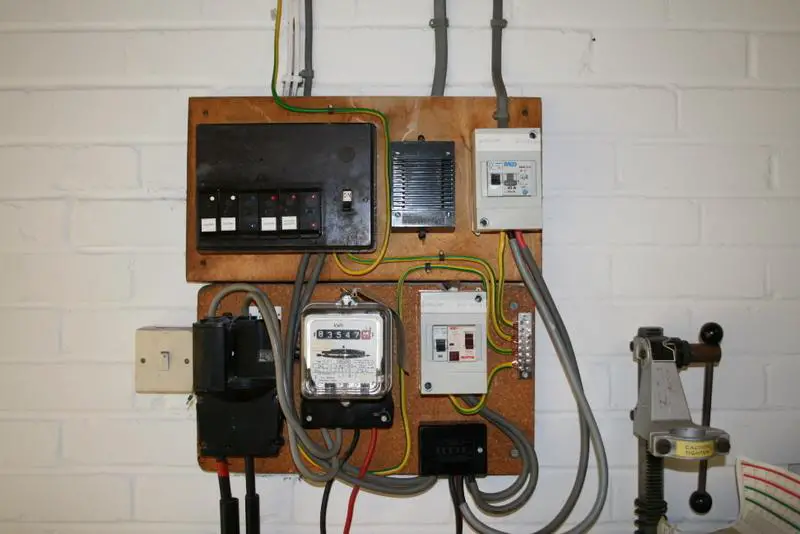Hi guys,
I've got an old Wylex CU with rewirable fuses which I'd like to upgrade to a modern CU with circuit breakers and (presumably) RCD protection.
NB. Main fuse is 60A. The two separate 40A RCDs serve two electric showers - 10.8kW via 10mm2 cable & 9.5kW via 6mm2 (the latter of which will be removed when the bathroom is renovated). In the meantime, we never run both showers at the same time !
The house was built in 1972 and it's not been rewired to my knowledge, however the wiring appears to be in good condition. I've replaced all the sockets and have done a number of other jobs round the house (replacing the whole CH system, moving light switches, adding extra sockets etc) which have given me a good insight into how the house is wired and the overall good condition of the wiring, although I obviously don't have the expertise and testing equipment to know for sure.
There are a number of issues I have come across however and I was wondering whether any of these would have to be addressed with a CU upgrade ? These are :
1) Rather than an upstairs/downstairs split, the ring main is split into right-hand side/left-hand side of the house - the upstairs RHS circuit sends spurs to the rooms beneath and the downstairs LHS circuit sends spurs to the rooms above.
2) The lighting circuits are divided into upstairs/downstairs, but the upstairs landing light (which is on the downstairs circuit) has a shared neutral with the upstairs circuit.
3) The double light switch outside the upstairs bathroom (which also controls the landing light) can still be live when the upstairs fuse is pulled (presumably as a consequence of no.2 ?) I've not yet tested whether this is all the time or only when landing light is switched on from downstairs.
4) The kitchen is on the ring main for the side of the house closest to the CU and not on it's own circuit. (currently 3 double sockets but will probably add more in the future). The electric cooker is on it's own circuit, however.
I'm curious to find out which, if any, of these would definitely have to be sorted out in order for the job to meet modern standards (and presumably allow the job to be signed off by the electrician changing the CU).
Thanks in advance for any comments.
I've got an old Wylex CU with rewirable fuses which I'd like to upgrade to a modern CU with circuit breakers and (presumably) RCD protection.
NB. Main fuse is 60A. The two separate 40A RCDs serve two electric showers - 10.8kW via 10mm2 cable & 9.5kW via 6mm2 (the latter of which will be removed when the bathroom is renovated). In the meantime, we never run both showers at the same time !
The house was built in 1972 and it's not been rewired to my knowledge, however the wiring appears to be in good condition. I've replaced all the sockets and have done a number of other jobs round the house (replacing the whole CH system, moving light switches, adding extra sockets etc) which have given me a good insight into how the house is wired and the overall good condition of the wiring, although I obviously don't have the expertise and testing equipment to know for sure.
There are a number of issues I have come across however and I was wondering whether any of these would have to be addressed with a CU upgrade ? These are :
1) Rather than an upstairs/downstairs split, the ring main is split into right-hand side/left-hand side of the house - the upstairs RHS circuit sends spurs to the rooms beneath and the downstairs LHS circuit sends spurs to the rooms above.
2) The lighting circuits are divided into upstairs/downstairs, but the upstairs landing light (which is on the downstairs circuit) has a shared neutral with the upstairs circuit.
3) The double light switch outside the upstairs bathroom (which also controls the landing light) can still be live when the upstairs fuse is pulled (presumably as a consequence of no.2 ?) I've not yet tested whether this is all the time or only when landing light is switched on from downstairs.
4) The kitchen is on the ring main for the side of the house closest to the CU and not on it's own circuit. (currently 3 double sockets but will probably add more in the future). The electric cooker is on it's own circuit, however.
I'm curious to find out which, if any, of these would definitely have to be sorted out in order for the job to meet modern standards (and presumably allow the job to be signed off by the electrician changing the CU).
Thanks in advance for any comments.


